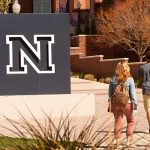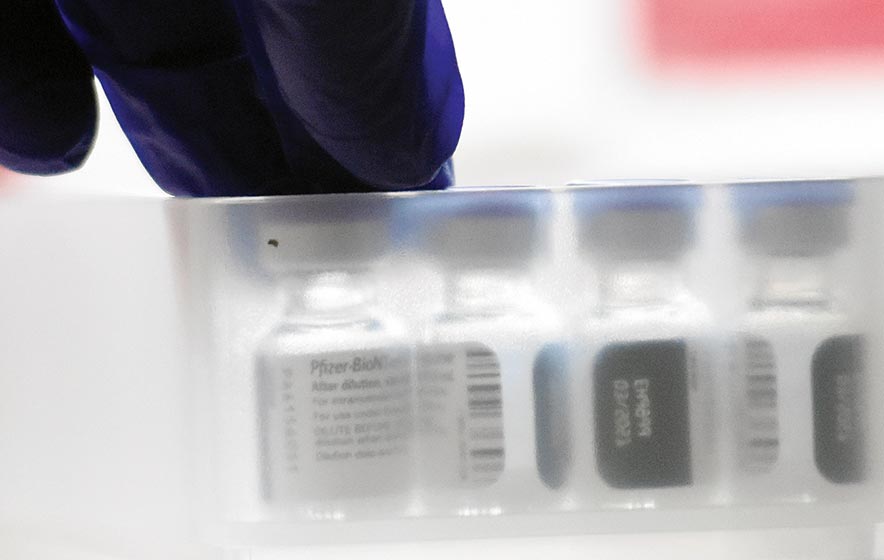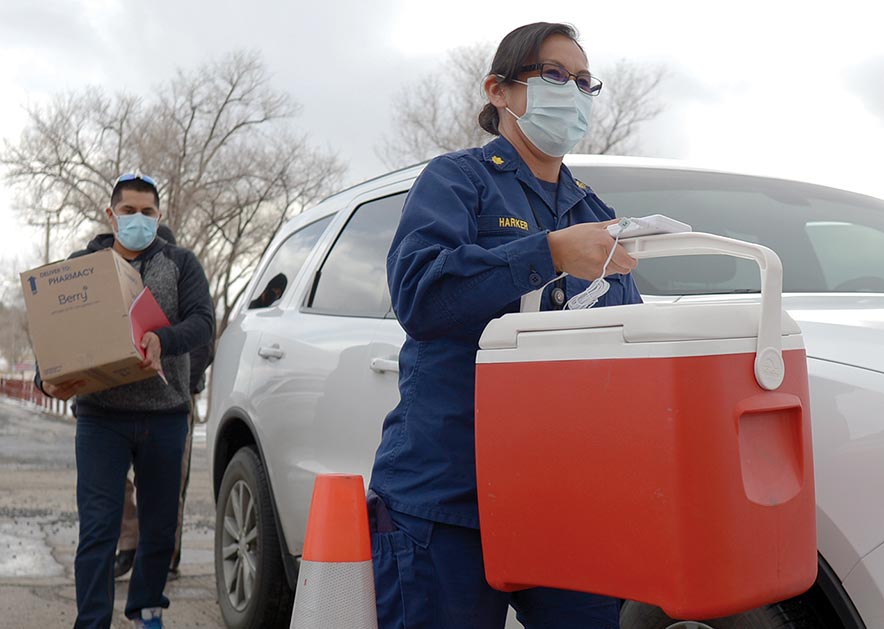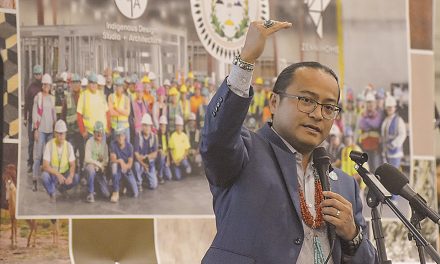
‘Historic’ vaccine rollout underway

Navajo Times | Donovan Quintero Commander Erica Harker with the U.S. Public Health Service places vials of the Pfizer vaccine into a container on Monday at the Sage Memorial Hospital in Ganado.
WINDOW ROCK
The first 3,900 doses of Pfizer vaccine arrived at Gallup Indian Medical Center this week and launched distribution to the first priority group within Navajo Area Indian Health Service units and tribal health organizations, which includes frontline health care workers, first responders, traditional practitioners and patients in long-term care facilities.
On Tuesday, Dr. Eric Ritchie, Chinle Service Unit chief medical officer, said it was a “historic and very emotional day” as vaccinations began.
“Now we’re able to roll out a vaccine that’s proven to be safe and effective at preventing the COVID-19 virus,” said Ritchie. “Our health care workers are receiving that vaccine today.”
Last week, during a president’s office virtual town hall, Navajo Area IHS Chief Medical Officer Loretta Christensen said her team has closely followed the progress of the vaccine.
“We all support it and believe it will be effective, and we do encourage you to please get the vaccine when it’s your turn,” Christensen said.
As the vaccine supply increases, IHS and tribal health organizations will continue to prioritize who gets the vaccinations based on factors such as occupation, age, existing health problems and other considerations that increase the risk of severe illness or death from COVID-19.

Navajo Times | Donovan Quintero
DQ-Vaccine1
Navajo Times | Donovan Quintero
Commander Erica Harker with the U.S. Public Health Service carries the Pfizer vaccine on Monday into Sage Memorial Hospital in Ganado. A total of 33 vials were given to the hospital.
Another 7,800 doses of the Moderna vaccine, approved by the FDA on Tuesday, are expected to arrive by early next week. “To enable equitable and expedient distribution of COVID vaccine, the IHS has worked with tribal communities to design distribution plans based on the unique populations and geographical characteristics of the communities,” said IHS COVID-19 Vaccine Task Force lead Rear Adm.
Francis Frazier. IHS is also committed to reporting any adverse events related to the vaccine. Christensen said in the first part of 2021, they will be asking more of the general population to come in for the vaccinations, much like they do with the flu vaccinations.
“We will be able to order vaccines that we feel are best for our people on Navajo and we will be able to give it to the rest of the population in Phase Two,” she said.
Phase 3 is anticipated to occur later in the spring when the approved vaccines are expected to become widely available. “We want you to know that we have great confidence in the vaccines that are coming out,” said Christensen. “Getting the vaccine is voluntary, but we do need your help to try to stop COVID.”
Meanwhile, Christensen said while it is very important to vaccinate as many people as possible, it is also necessary to continue practicing all of the COVID-19 safety measures. “We all love our families and our friends,” said Christensen. “We want to see them, but we are asking you please do not do that right now until we can get COVID slowed down again. “Please stay home,” she said.
“Don’t visit, don’t have events, don’t have ceremonies because it is dangerous to gather at this time.”
‘Vaccine offers hope’
Over 44,000 participants in six countries volunteered for the Pfizer vaccine clinical trial.
According to Dr. Laura Hammitt, director of infectious disease at the Johns Hopkins Center for American Indian Health, who oversees the trial on Navajo, a total of 463 Native Americans have participated in the study, including 163 Diné and Apaches. Last week, the FDA reported 95% efficacy for the Pfizer vaccine after the required two doses, which are given 21 to 28 days apart.
“The vaccine is very effective in preventing COVID disease,” said Hammitt. She said, generally, mild side effects were reported among participants, including pain where the shot was given, tiredness, muscle aches and headaches. “These side effects were temporary and went away after a couple of days,” she said.
Older adults were found to be less likely to have side effects, she added.
“We know that COVID-19 is surging right now and that our families are suffering but this vaccine offers hope and it is a truly remarkable achievement,” said Hammitt. “We’re very honored to have had the opportunity to contribute to combatting COVID-19 with the Navajo Nation.”
Hammitt says she will not hesitate to take the vaccine and will be encouraging her family to do the same. Michael Tutt, chief medical officer at Tsehootsooi Medical Center, has also stated he would take the vaccine but urged everyone to continue to follow the safety guidelines as the vaccine rolls out.
“As Navajo, we’ve gone through so many calamities starting from the time we came onto this land,” he said. “Now we face this invisible enemy that we can’t see so it’s hard to defend ourselves.” He said a similar situation occurred in 1918 when the Spanish flu “stormed through the world.”
“It also affected our Navajo Nation, where families perished inside their homes because they couldn’t take care of each other,” he said. “Back then, they didn’t have antibiotics or vaccines. All they had were facemasks and the ability to distance themselves from each other. That type of measure is still applicable to 2020.”
Tutt said because many people in the United State have not adhered to that basic strategy, the country is now being “overrun” with COVID-19. “What is happening now is within families,” he said. “Somebody comes to the house and a lot of these people who are contagious don’t have symptoms. They can give you COVID.”
Tutt said he’s seen grandfathers, grandmothers, mothers, fathers, brothers and sisters perish because COVID-19 has taken over their bodies. “The virus is doing a lot of damage to the people,” said Tutt. “It’s real. It’s not fake. “I go into the ICU and I see it,” he said. “People struggling to breathe. Families not able to see their loved ones.
“It is a strain on them, not just physically, but mentally,” he said. “It has stressed us to the max: the providers, the nurses, respiratory therapists… It’s taking a toll on them. You can see it. You can feel it.” Tutt said, as a physician and a father, his message to Navajos is to continue to practice those same tactics that were used in 1918.
“Make sure you wear your facemask, maintain distance and wash your hands and we will overcome this virus that has invaded our Navajo Nation,” he said.
As a public service, the Navajo Times is making all coverage of the coronavirus pandemic fully available on its website. Please support the Times by subscribing.
How to protect yourself and others.
Why masks work. Which masks are best.
Resources for coronavirus assistance








 Highway 264,
Highway 264, I-40, WB @ Winslow
I-40, WB @ Winslow